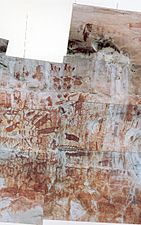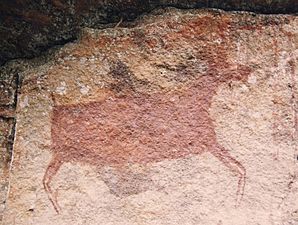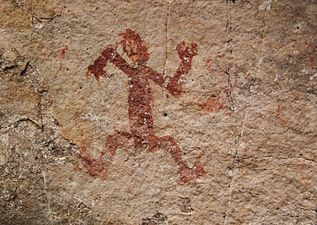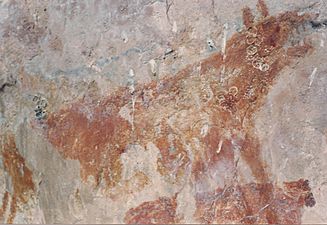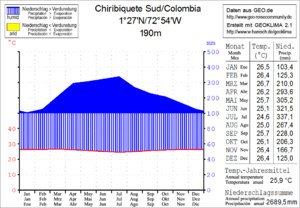Chiribiquete National Park facts for kids
Quick facts for kids Chiribiquete National Natural Park |
|
|---|---|
| PNN Serranía de Chiribiquete | |
|
IUCN Category II (National Park)
|
|

Tepui in the Park
|
|

Map of the national park
|
|
| Nearest city | San José del Guaviare |
| Area | 43,000 km2 (17,000 sq mi) |
| Established | 1989 |
| Official name: Chiribiquete National Park – “The Maloca of the Jaguar” | |
| Type: | Mixed |
| Criteria: | (iii), (ix), (x) |
| Designated: | 2018 (42nd session) |
| Reference #: | 1174 |
| Region: | South America |
Chiribiquete National Natural Park is the largest national park in Colombia. It is also the biggest tropical rainforest national park in the world! This amazing park was created on September 21, 1989. It has grown bigger twice since then. First in 2013, and again in 2018. The park covers about 43,000 km2 (17,000 sq mi). It includes the Serranía de Chiribiquete mountains and the flat lands around them. These areas are covered by thick tropical forests, savannas, and many rivers.
Contents
Park History
Chiribiquete National Natural Park first opened on September 21, 1989. It started as a smaller park.
How the Park Grew
The park was made much larger on August 21, 2013. It grew from 13,000 km2 (5,000 sq mi) to 28,000 km2 (11,000 sq mi). On February 21, 2018, the president of Colombia, Juan Manuel Santos, said the park would get even bigger. It was expanded to its current size of 43,000 km2 (17,000 sq mi). On July 2, 2018, UNESCO also named it a World Heritage Site. This means it's a very special place for everyone in the world.
Ancient Rock Art
This park is not only full of nature, but also amazing ancient art! You can find lots of rock art here. More than 600,000 drawings and carvings have been found. These are called petroglyphs (carvings) and pictographs (paintings). Indigenous people made them on rock walls. They started making art about 20,000 years ago. Some groups of people who live without contact with the outside world still make art today.
Discovering the Art
Some of these paintings were first photographed in 1986 and 1987. A geologist named Jaime Galvis took the pictures. Later, more research was done by Carlos Castaños and Thomas van der Hammen. In 2014, a filmmaker named Mike Slee and a photographer named Francisco Forero Bonell filmed and photographed the art. They captured the paintings on the tall rock faces inside the park.
Gallery of Rock Art
|
|
Park Geography
Chiribiquete National Park is located in the northwest part of the Colombian Amazon. It is found in the departments of Caquetá and Guaviare.
Mountains and Plateaus
The park is in the western part of the Guiana Shield. This is an ancient landmass. The land in the park goes from about 200 to 1,000 metres above sea level. It has cool rock formations like flat-topped mountains called tepuis. These tepuis rise suddenly from the forest floor. The Chiribiquete mountain range is a very old part of the Precambrian and Paleozoic rock formations.
Water Systems
Chiribiquete National Park has many important drainage basins. These are areas where water collects and flows into rivers. Most of the rivers in the park flow into the Caquetá River. The Caquetá River then flows into the mighty Amazon River. Many of the rivers here are called blackwater rivers. Their water looks dark because of natural materials from the soil.
Park Climate
Chiribiquete National Natural Park has a tropical climate. It gets about 4,500 mm of precipitation (rain) each year. The mountains cause a lot of cloud cover. The least rain falls between December and February. The most rain falls between April and July. The average temperature is 24 °C (75 °F). Temperatures can change a lot between day and night. In dry months, it can get up to 32 °C (90 °F) during the day. At night, it can drop to 20 °C (68 °F). Higher parts of the park are much cooler. They can drop to 2 °C (36 °F). The air is usually very humid, especially at night.
Amazing Plants (Flora)
Chiribiquete is home to 30% of all the plants and ecosystems in the Colombian Amazon. Scientists have found 1,801 different plant species here so far. The tropical forests are very old and tall. Some trees can grow up to 40 m (130 ft) high.
Common Trees and Unique Plants
Some common trees include the Amazon tree-grape (Pourouma cecropiifolia) and the ucuuba (Virola sebifera). The forest floor is very dense. It has many plants that grow on other plants, like epiphytic plants. In the mountains, you can find thick bushes that are about 12 and 15 m (39 and 49 ft) tall. Places with little soil, like around waterfalls, have many unique plants. These plants are found nowhere else in the world.
Wonderful Animals (Fauna)
Chiribiquete is full of incredible animals! Scientists have found:
- 209 butterfly species
- 238 fish species
- 57 amphibian species (like frogs and salamanders)
- 60 reptile species (like snakes and lizards)
- Over 410 bird species
- 82 mammal species
Many of these animals are rare or only found in this area. The park has many unique amphibians and freshwater fish. It also has about 30% of all the different bats in the Colombian Amazon. Plus, 10% of all the butterflies in Colombia live here!
Birds of Chiribiquete
Some of the most special birds you might see are the Guianan cock-of-the-rock and the bright scarlet macaw. You can also find different kinds of kingfishers and the oilbird. A very special bird found only here is the Chiribiquete emerald hummingbird. Other birds include tinamous, curassows, and motmots. You might even spot a huge harpy eagle flying overhead!
Mammals of Chiribiquete
Scientists have found 52 types of bats in the park. This is a huge number! Some bats include dog-like bats and Marinkelle's sword-nosed bat. The park is also home to many big carnivorans (meat-eaters). These include the giant otter, ocelot, cougar, and the powerful jaguar.
Primates and Other Animals
There are 8 types of primates (monkeys) living here. These include the white-fronted capuchin and the brown woolly monkey. You can also find armadillos, the huge giant anteater, and the Amazon river dolphin in the rivers. Other amazing animals are the white-lipped peccary and the large Brazilian tapir.
Images for kids
See also
 In Spanish: Parque nacional natural Sierra de Chiribiquete para niños
In Spanish: Parque nacional natural Sierra de Chiribiquete para niños


